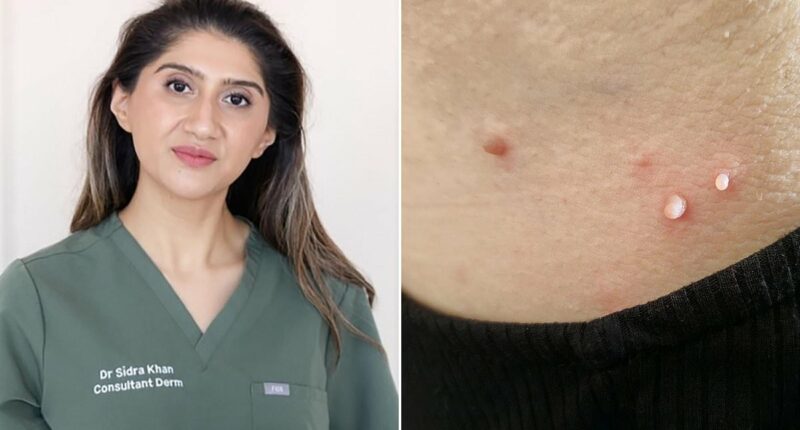Share this @internewscast.com
Ever had a skin-coloured growth that seems to have appeared out of nowhere on your neck, underarm, groin, eyelid, or almost anywhere else?
It’s likely to be a skin tag – or to give it its proper name, an acrochordon.
Skin tags are often mistaken for warts, which are generally harder and rougher, or moles, which are usually flatter and a different color from the skin. However, unlike warts and moles, skin tags are generally harmless, painless, and can look like tiny flaps of skin hanging off the body.
They might begin as barely noticeable flat bumps but can grow to a few millimeters, and occasionally up to a couple of centimeters in length, hanging from the body.
Essentially they’re overgrowths of skin that are composed of collagen fibres – one of the proteins that make up skin – and blood vessels.
“They tend to form in areas of friction, where the skin rubs against skin or clothing,” says Dr. Sidra Khan, a consultant dermatologist based in Glasgow. Although they are very common, “we tend to see them more often in people who are overweight or pregnant,” and their occurrence increases with age too.
However, the specific mechanism behind how and why they develop is not yet fully understood, according to Dr. Khan. “Hormonal and metabolic factors are believed to contribute to the stimulation of skin tissue overgrowth.”

Ever noticed a skin-coloured growth that appears to have come out of nowhere? It’s likely to be a skin tag—or in its scientific term, an acrochordon.

And if you are tempted to remove them at home, there are various skin tag remover kits that are for sale
It is thought that growth hormones may be involved, and one study found evidence that suggested the friction could be triggering an immune response similar to that involved in wound-healing, hence the stimulation of collagen fibres and skin growth.
Many people will have the odd one or two, but some may have hundreds. And while they might look unsightly, there’s probably no cause for alarm.
This is why Professor Firas Al-Niaimi, a London-based consultant dermatologist, warns ‘while they are themselves benign, if they appear alongside other signs, such as obesity, thickening or darkening of the skin in body folds, this may indicate an underlying hormonal disorder, such as diabetes, and so should be checked by a medical professional.’
Skin tags are not contagious, but there’s some research that suggests that there’s a genetic element as they seem to run in families.
Other risk factors include age – the older you are, the more likely you are to get skin tags, possibly due to the fact that skin loses elasticity with age, making it more prone to folding and rubbing against itself.

Dr Sidra Khan, a consultant dermatologist based in Glasgow
From a medical perspective, there’s no real clinical need to remove skin tags.
‘Skin tags are often removed for cosmetic reasons,’ says Professor Al-Niaimi, ‘but removal may also be considered if they become irritated by clothing, jewellery or friction. Rarely, they can become inflamed or infected, prompting patients to seek treatment.’
A tag is unlikely to disappear on its own, says Dr Khan: ‘It’s possible that one could twist on itself, lose its blood supply and drop off – but that’s not typical.’
In a clinic, there are a number of ways in which skin tags can be removed.

Professor Firas Al-Niaimi, a London-based consultant dermatologist
‘Depending on the size, I tend to use electrocautery – using an electric device that applies controlled heat that destroys the skin tag tissue, while sealing the skin around it to minimise bleeding,’ says Professor Al-Niaimi.
‘Or there’s shave excision: using a scalpel to cut the skin tag off at the base.’ The larger the tag, the more likely a practitioner is to use electrocautery as this minimises bleeding, he says: ‘Electrocautery is appropriate for smaller tags but when the stalk gets broader and the tag is larger, shave excision is a better choice.’
Other ways to remove skin tags include cryotherapy, where the tag is frozen off, using liquid nitrogen.
You cannot get skin tags removed on the NHS as it is considered cosmetic surgery – and privately you can expect to pay anything from around £50 to £175 to remove one.
‘Generally speaking, these are quick, low-risk procedures that don’t require any anaesthetic,’ says Dr Khan.
Once treated, a tag will not ‘grow back’, however it is possible that further friction in the same place could cause another one to form.
And if you are tempted to remove them at home, there are various skin tag remover kits that are for sale.
They tend to use the principles of cryotherapy, but rather than using liquid nitrogen, rely on propellants in an aerosol that turn from liquid to gas on contact with the skin, and take energy, in the form of heat, from the skin in order to do this.
However, some experts say that they are unlikely to be effective as they don’t reach low enough temperatures to kill the tissues.
Other kits work by applying tiny elastic bands to the base of the tag in the hope of cutting off their blood supply so they fall off.
Another much-touted approach on social media is the application of apple cider vinegar, the idea being that the acid irritates the tissues of the tag until they die.
Perhaps understandably, professionals are not in favour of these DIY approaches, which they say at best, don’t work – and at worst, ‘could lead to infection, bleeding and scarring’, says Dr Khan. ‘I would strongly advise against individuals attempting to remove skin tags at home.’
Possibly more importantly, you could be removing something that, to the untrained eye, looks like a skin tag, but actually turns out to be a mole or a cancerous growth that needs to be biopsied and treated properly.
That’s why Dr Khan says that, for the avoidance of doubt, it’s always advisable to have any new or changing skin growth checked out by an appropriately trained healthcare professional.















